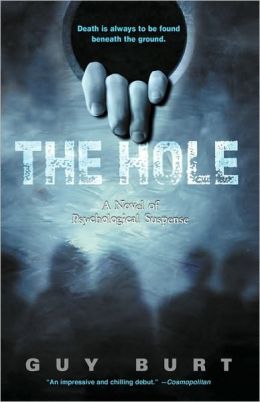The Hole
by Guy Burt
Ballantine, 1993
152 Pages
Young Adult
![]()
![]()
Five teenagers take part in a school prank, hoping to become legends. Geoff, Mike, Liz, Frankie, and Alex are all to participate in an elaborate joke by class prankster Martyn. Martyn calls it an “experiment with real life.” They will allow themselves to be locked in a forgotten WWII bunker for three days to avoid a school field trip. Their parents will think they are mountain climbing while the school will believe they had stayed home. It seems like a flawless plan. Martyn’s plans are always perfect. But after three days pass, Martyn doesn’t show up to let them out.
Martyn’s a perfectly normal guy. A bright, articulate, charismatic guy who just happens to think he’s God and that other people are playthings.
The Hole will pull you in right away, and it moves quick because once you get lost in the mind of a master, there’s no putting the book down. Whether it’s Sherlock Holmes or Hannibal Lechter, a game of mental one-upsmanship is thrilling.
The narrative switches between the real-time experiences of a participant, Liz, and the flashback account she is writing of what happened in The Hole. There are also taped interviews with Lisa, Martyn’s girlfriend. It’s a slow burn, a psychological thriller, based not on action but the choices of the characters and the horror of the situation they find themselves in.
We feel the tension as nervous jokes turn into fear and anger. One by one, the things that give the students hope and comfort are removed. The water shuts off and the situation becomes deadly serious. Then the lights go out. It becomes a game of chess, Liz pitting her bluff against Martyn’s ego in a final gambit for their survival.
[It was] too unbelievable. You don’t examine every inch of a prank suggested by the school wit to see if it’s going to cost you your life; there’s no need.
If only we had, for some strange reason, done just that. If only one of us –for any reason– had decided not to do the Hole, the entire fabric of the thing would have been rendered useless to Martyn.”
It is a study of the mental processes not only of the participants locked inside the crucible of horror, but of the mindset of the genius sociopath who orchestrated The Hole. The story can be confusing if you aren’t paying attention, but stay with it, because the epilogue is a mind-blower that turns everything you think happened on its head. It makes a re-read well worthwhile, because the clues are there.
I ruminated over this book for days after I read it, going back to the ending because the resolution wasn’t clearly spelled out. Like Saw II*, the story lets you figure out what really happened, who the real mastermind really was, and what different motives were in play.
There was a movie made of the story back in 2001, directed by Nick Hamm, which I was unaware of when I picked up the book. (Not to be confused with Joe Dante’s The Hole (2001), which is also an excellent flick about a trap door in two brothers’ basement.) Unfortunately, Hamm’s movie was never released in US theaters. But Our Glorious Netflix offered us instant access to compare the stories!
The movie version focuses on the relationship between Liz and Mike, a minor sub-theme of the novel. It received an R rating in the US, but I’d have to say the book probably should, too. What it does offer (besides Keira Knightley from Pirates of the Caribbean,) is a dramatization of what happened at the very end of the experiment, which was purposely left vague in the novelization. It blatantly calls into question Elizabeth’s account of the story relating to the role Martyn played in the ordeal.
The movie is great on its own, though I prefer the book’s subtlety. The acting is seamless, and the characters well cast. Because of the major difference in the approach to telling the story, the book should be read before the you watch screen version if you plan to experience both, which I highly recommend. The novel is a psychological gut-clencher for which the movie is the catharsis.
Note: This novel was released in a later edition with the name After The Hole. It is not a sequel, but a different name for the same book.
*In Saw II, a similar story of people trapped in a house, the participants are required to work together to escape. If they can figure out the clues tattooed on each person’s neck, they get out alive. They don’t, of course, and the puzzle is never explained, though it can be figured out by the observant viewer.
 |
 |

